_______ _______ is the study of populations in relation to environment, including environmental influences on density and distribution, age structure, and population size.
Population ecology
A _________ is a group of individuals of a single species living in the same general area.
population
_________ is the number of individuals per unit area or volume.
Density
__________ is the pattern of spacing among individuals within the boundaries of the population.
Disperson
The _________ ________ of a population refers to the way individuals are spaced within their area. They can be clumped, uniform, and random.
dispersion pattern
__________ is the study of the vital statistics of a population and how they change over time.
Demography
a _______ ________ is an age-specific summary of the survival pattern of a population.
life table
_________ _______ plot the proportion of individuals alive at each age.
survivorship curves
Type ___: low death rates during early and middle life, then an increase in death rates among older age groups.
1
Type ___: the death rate is constant over the organisms's life span.
2
Type ___: high death rates for the young, then a slower death rate for survivors.
3
__________ growth model: the rate of population increases under ideal conditions, and cannot be sustained for long in any population.
Exponential
________ growth model: this growth model takes into account limiting factors, environmental factors that restrict population growth.
Logistic
__-selection, or density-dependent selection, selects for life history traits that maximize reproduction.
K
__-selection, or density-inependent selection, selects for life history traits that maximize reproduction.
r
In density-___________ populations, birth rate and death rate do not change with population density.
independent
In density-__________ populations, birth rates fall and death rates rise with population density.
dependent
the study of ________ ________ focuses on the complex interactions between biotic and abiotic factors that cause variation in population size.
population dynamics
___________ are groups of populations linked by immigration and emigration.
Metapopulations
The _________ _________ concept summarizes the aggregate land and water area needed to sustain the people of a nation.
ecological footprint
Population ecologists are primarily interested in
A) studying
interactions among populations of organisms that inhabit the same
area.
B) understanding how biotic and abiotic factors influence
the density, distribution, size, and age structure of populations.
C) how humans affect the size of wild populations of organisms.
D) how populations evolve as natural selection acts on heritable
variations among individuals and changes in gene frequency.
E)
the overall vitality of a population of organisms.
Answer: B
A population is correctly defined as having which of the following characteristics?
I. inhabiting the same general area
II. belonging to the same
species
III. possessing a constant and uniform density and dispersion
A) I only
B) III only
C) I and II only
D) II and
III only
E) I, II, and III
Answer: C
An ecologist recorded 12 white-tailed deer, Odocoileus virginianus,
per square mile in one woodlot and 20 per square mile in another
woodlot. What was the ecologist comparing?
A) density
B)
dispersion
C) carrying capacity
D) cohorts
E) range
Answer: A
During the spring, you are studying the mice that live in a field
near your home. The population density is high, but you realize that
you rarely observe any reproductive female mice. This most likely
indicates
A) that there is selective predation on female mice.
B) that female mice die before reproducing.
C) that this
habitat is a good place for mice to reproduce.
D) that you are
observing immigrant mice.
E) that the breeding season is over.
Answer: D
Uniform spacing patterns in plants such as the creosote bush are most
often associated with
A) chance.
B) patterns of high
humidity.
C) the random distribution of seeds.
D)
competitive interaction between individuals of the same population.
E) the concentration of nutrients within the population's range.
Answer: D
To construct a reproductive table for a sexual species, one needs to
A) assess sperm viability for the males in the population.
B) keep track of all of the offspring of a cohort.
C) keep
track of the females in a cohort.
D) keep track of all of the
offspring of the females in a cohort.
E) analyze the ratio of
deaths to births in a cohort.
Answer: C
Which of the following sets of measurements is the most useful when
studying populations?
A) density, dispersion, and demographics
of a population
B) gene frequency over time and the ratio of
reproductive to nonreproductive individuals
C) annual
precipitation averages and mean annual temperatures
D) minimum
and maximum amounts of precipitation and annual temperature extremes
E) ratio of predators and the number of immigrants and emigrants
Answer: A
Which of the following scenarios would provide the most legitimate
data on population density?
A) Count the number of nests of a
particular species of songbird and multiply this by a factor that
extrapolates these data to actual animals.
B) Count the number
of pine trees in several randomly selected 10 m x 10 m plots and
extrapolate this number to the fraction of the study area these plots
represent.
C) Use the mark-and-recapture method to estimate the
size of the population.
D) Calculate the difference between all
of the immigrants and emigrants to see if the population is growing or
shrinking.
E) Add the number of births and subtract the
individuals that die to see if the population's density is increasing
or decreasing.
Answer: B
Which of the following best defines a cohort?
A) a group of
individuals that inhabits a small isolated region within the range for
the species
B) all of the individuals that are annually added to
a population by birth and immigration
C) the reproductive males
and females within the population
D) a group of the individuals
from the same age group, from birth until they are all dead
E)
the number of individuals that annually die or emigrate out of a population
Answer: D
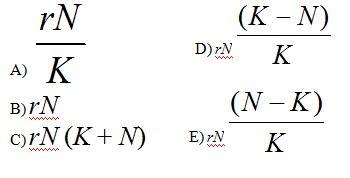
Exponential growth of a population is represented by dN/dt =
A. SEE IMAGE
B. SEE IMAGE
C. SEE IMAGE
D. SEE
IMAGE
E. SEE IMAGE
Answer: B
Starting from a single individual, what is the size of a population
of bacteria that reproduce by binary fission every 20 minutes at the
end of a 2-hour time period? (Assume unlimited resources and no
mortality.)
A) 6
B) 18
C) 128
D) 512
E) 1,024
Answer: D
Which of the following is the equation for zero population
growth (ZPG)?
A) R = b - m
B) dN/dt = rN
C)
dN/dt =rmax N (K -N)/K
D) dN/dt =rmax N
E) dN/dt = 1.0N
Answer: A
In July 2008, the United States had a population of approximately
302,000,000 people. How many Americans were there in July 2009, if the
estimated 2008 growth rate was 0.88%?
A) 2,700,000
B)
5,500,000
C) 303,000,000
D) 304,000,000
E) 2,710,800,000
Answer: D
In 2008, the population of New Zealand was approximately 4,275,000
people. If the birth rate was 14 births for every 1,000 people,
approximately how many births occurred in New Zealand in 2008?
A) 6,000
B) 42,275
C) 60,000
D) 140,000
E) 600,000
Answer: C
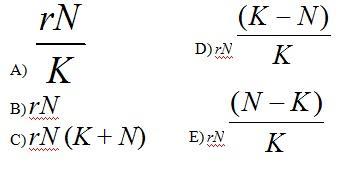
Logistic growth of a population is represented by dN/dt =
A. SEE IMAGE
B. SEE IMAGE
C. SEE IMAGE
D. SEE
IMAGE
E. SEE IMAGE
Answer: D
As N approaches K for a certain population, which of the following is
predicted by the logistic equation?
A) The growth rate will not
change.
B) The growth rate will approach zero.
C) The
population will show an Allee effect.
D) The population will
increase exponentially.
E) The carrying capacity of the
environment will increase.
Answer: B
In models of logistic population growth,
A) the population
growth rate slows dramatically as N approaches K.
B) new
individuals are added to the population most rapidly at the beginning
of the population's growth.
C) new individuals are added to the
population as N approaches K.
D) only density-dependent factors
affect the rate of population growth.
E) carrying capacity is
never reached.
Answer: A
Carrying capacity is
A) seldom reached by marine producers and
consumers because of the vast resources of the ocean.
B) the
maximum population size that a particular environment can support.
C) fixed for most species over most of their range most of the
time.
D) determined by density and dispersion data.
E) the
term used to describe the stress a population undergoes due to limited resources.
Answer: B
Which of the following causes populations to shift most quickly from
an exponential to a logistic population growth?
A) increased
birth rate
B) removal of predators
C) decreased death rate
D) competition for resources
E) favorable climatic conditions
Answer: D
Which of the following statements about the evolution of life
histories is correct?
A) Stable environments with limited
resources favor r-selected populations.
B) K-selected
populations are most often found in environments where
density-independent factors are important regulators of population
size.
C) Most populations have both r- and K-selected
characteristics that vary under different environmental conditions.
D) The reproductive efforts of r-selected populations are
directed at producing just a few offspring with good competitive
abilities.
E) K-selected populations rarely approach carrying capacity.
Answer: C
Which of the following is characteristic of K-selected populations?
A) offspring with good chances of survival
B) many
offspring per reproductive episode
C) small offspring
D) a
high intrinsic rate of increase
E) early parental reproduction
Answer: A
Which of the following is most likely to contribute to
density-dependent regulation of populations?
A) the removal of
toxic waste by decomposers
B) intraspecific competition for
nutrients
C) earthquakes
D) floods
E) fires
Answer: B
Why do populations grow more slowly as they approach their carrying
capacity?
A) Density-dependent factors lead to fewer births and
increased mortality.
B) Density-independent factors lead to
fewer births and increased mortality.
C) Hormonal changes
promote higher death rates in crowded populations.
D)
Individuals voluntarily stop mating so that overcrowding does not
occur.
E) The incoming energy decreases in populations
experiencing a high rate of increase.
Answer: A
Which of the following could be a
density-independent factor limiting human population
growth?
A) social pressure for birth control
B)
earthquakes
C) plagues
D) famines
E) pollution
Answer: B
An ecological footprint is a construct that is
useful
A) for a person living in a developed nation to consider
to make better choices when using global food and energy resources.
B) for a person living in a developing country to see how much
of the world's resources are left for him/her.
C) in converting
human foods' meat biomass to plant biomass.
D) in making
predictions about the global carrying capacity of humans.
E) in
determining which nations produce the least amount of carbon dioxide
from the burning of fossil fuels.
Answer: A
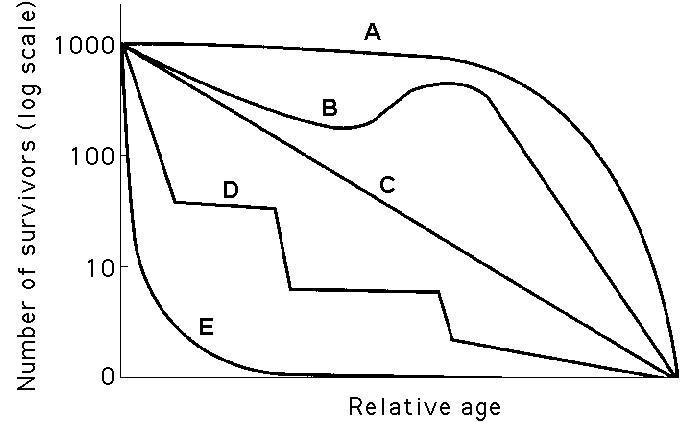
Which statement best explains survivorship curve B?
A) It is
likely a species that provides little postnatal care, but lots of care
for offspring during midlife as indicated by increased survivorship.
B) This curve is likely of a species that produces lots of
offspring, only a few of which are expected to survive.
C) It is
likely a species where no individuals in the cohort die when they are
at 60—70% relative age.
D) There was a mass emigration of young
to middle-aged individuals in this cohort.
E) Survivorship can
only decrease; therefore, this curve could not happen in nature.
Answer: E
A population's carrying capacity
A) may change as environmental
conditions change.
B) can be accurately calculated using the
logistic growth model.
C) generally remains constant over time.
D) increases as the per capita growth rate (r) decreases.
E) can never be exceeded.
Answer: A
During exponential growth, a population always
A) grows by
thousands of individuals.
B) grows at its maximum per capita
rate.
C) quickly reaches its carrying capacity.
D) cycles
through time.
E) loses some individuals to emigration.
Answer: B
Why do some invertebrates, such as lobsters, show a
"stair-step" survivorship curve?
A) Many invertebrates
mate and produce offspring on multiyear cycles.
B) Within a
species of invertebrates, younger individuals have a higher
survivorship than older individuals.
C) Many invertebrates molt
in order to grow, and they are vulnerable to predation during their
"soft shell" stage.
D) Many invertebrate species have
population cycles that go up and down according to the frequency of
sunspots.
E) The number of fertilized eggs that mature to become
females in many species of invertebrates is based on ambient temperature.
Answer: C
Consider two forests: one is an undisturbed old-growth forest, while
the other has recently been logged. In which forest are species likely
to experience exponential growth, and why?
A) Old growth,
because of stable conditions that would favor exponential growth of
all species in the forest.
B) Old growth, because each of the
species is well established and can produce many offspring.
C)
Logged, because the disturbed forest affords more resources for
increased specific populations to grow.
D) Logged, because the
various populations are stimulated to a higher reproductive potential.
E) Exponential growth is equally probable in old-growth and
logged forests.
Answer: C
Natural selection involves energetic trade-offs between
A)
choosing how many offspring to produce over the course of a lifetime
and how long to live.
B) producing large numbers of gametes when
employing internal fertilization versus fewer numbers of gametes when
employing external fertilization.
C) the emigration of
individuals when they are no longer reproductively capable or
committing suicide.
D) increasing the number of individuals
produced during each reproductive episode with a corresponding
decrease in parental care.
E) high survival rates of offspring
and the cost of parental care.
Answer: E
In which of the following situations would you expect to find the
largest number of K-selected individuals?
A) a recently
abandoned agricultural field in Ohio
B) the sand dune
communities of south Lake Michigan
C) the flora and fauna of a
coral reef in the Caribbean
D) South Florida after a hurricane
E) a newly emergent volcanic island
Answer: C
Which of the following was the most significant limiting factor in
human population growth in the 20th century?
A) famine
B)
non-HIV disease
C) HIV
D) genocide
E) clean water
Answer: E
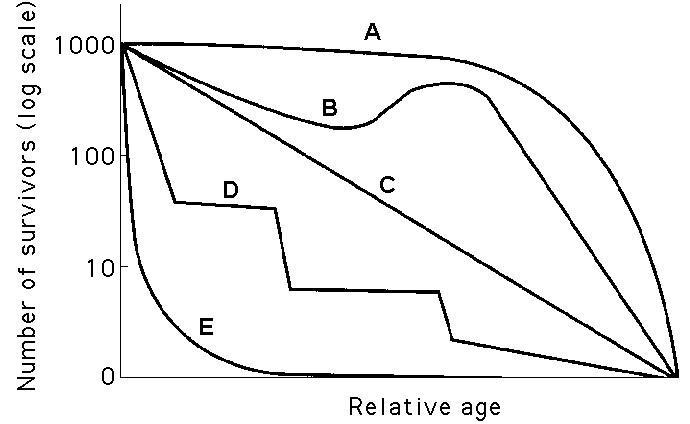
Which curve best describes survivorship in marine molluscs?
A)
A
B) B
C) C
D) D
E) E
Answer: E
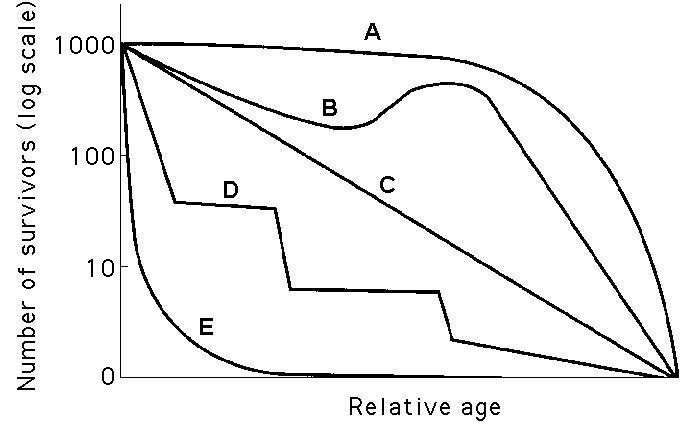
Which curve best describes survivorship in elephants?
A) A
B) B
C) C
D) D
E) E
Answer: A
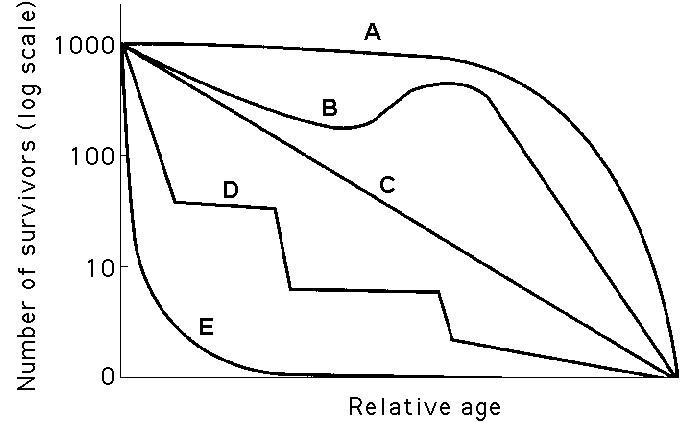
Which curve best describes survivorship in a marine crustacean that
molts?
A) A
B) B
C) C
D) D
E) E
Answer: D
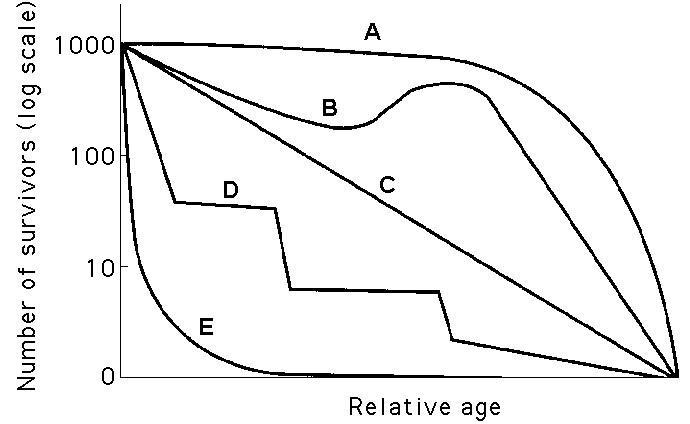
Which curve best describes survivorship in humans who live in
undeveloped nations?
A) A
B) B
C) C
D) D
E) E
Answer: A
Population ecologists follow the fate of same-age cohorts to
A)
determine a population's carrying capacity.
B) determine the
birth rate and death rate of each group in a population.
C)
determine if a population is regulated by density-dependent processes.
D) determine the factors that regulate the size of a population.
E) determine if a population's growth is cyclic.
Answer: B
A recent study of ecological footprints concluded that
A)
Earth's carrying capacity for humans is about 10 billion.
B)
Earth's carrying capacity would increase if per capita meat
consumption increased.
C) current demand by industrialized
countries for resources is much smaller than the ecological footprint
of those countries.
D) it is not possible for technological
improvements to increase Earth's carrying capacity for humans.
E) the ecological footprint of the United States is large
because per capita resource use is high.
Answer: E
The observation that members of a population are uniformly
distributed suggests that
A) the size of the area occupied by
the population is increasing.
B) resources are distributed
unevenly.
C) the members of the population are competing for
access to a resource.
D) the members of the population are
neither attracted to nor repelled by one another.
E) the density
of the population is low.
Answer: C

According to the logistic growth equation
SEE IMAGE
A) the number of individuals added per unit time is greatest when N
is close to zero.
B) the per capita growth rate (r) increases as
N approaches K.
C) population growth is zero when N equals K.
D) the population grows exponentially when K is small.
E)
the birth rate (b) approaches zero as N approaches K.
Answer: C
Which of the following statements about human population in
industrialized countries is incorrect?
A) Life history is
r-selected.
B) Average family size is relatively small.
C)
The population has undergone the demographic transition.
D) The
survivorship curve is Type I.
E) Age distribution is relatively uniform.
Answer: A